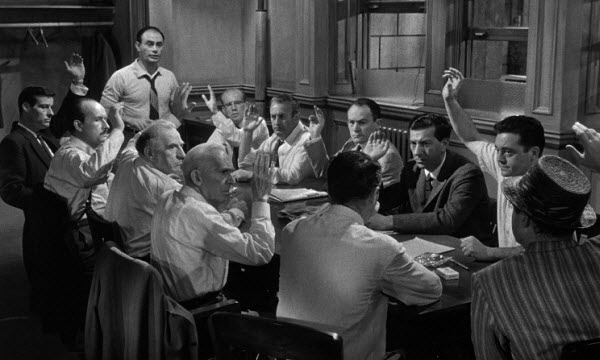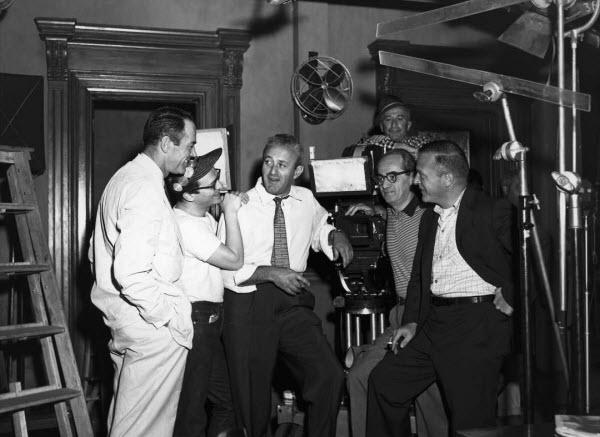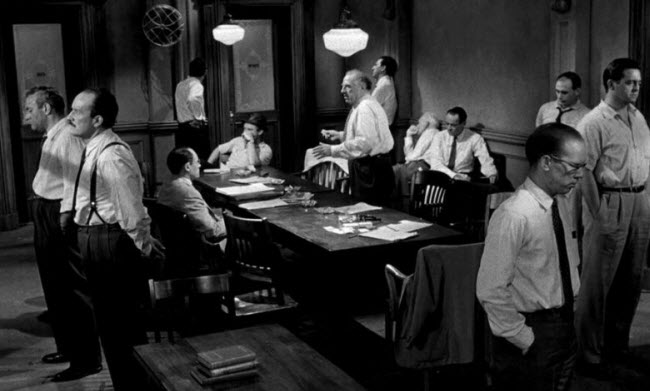“12 Angry Men” is a timeless classic that delves into the complexities of justice, prejudice, and moral responsibility. Directed by Sidney Lumet, this 1957 film is a gripping courtroom drama that examines the deliberations of a jury deciding the fate of a young defendant accused of murder. Known for its intense dialogue and powerful performances, “12 Angry Men” remains a landmark in cinematic history for its exploration of human nature and the justice system.

Plot Summary (Warning: Spoilers Ahead)
“12 Angry Men” unfolds in a single room where twelve jurors are tasked with determining the guilt or innocence of a teenage boy charged with murdering his father. The film begins with the jurors entering the deliberation room, where their initial vote is overwhelmingly in favor of a guilty verdict. However, Juror #8 (Henry Fonda) stands alone in his dissent, convinced that there is reasonable doubt about the defendant’s guilt.
As the deliberations progress, Juror #8 challenges the other jurors to reconsider the evidence, highlighting inconsistencies and biases. Through intense debate and personal revelations, the jurors confront their own prejudices and the weight of their decision. The film reveals the deep-seated biases of each juror and the impact of their personal experiences on their judgments.
By the end of the film, Juror #8’s insistence on examining the evidence critically sways the jury, leading to a unanimous not guilty verdict. The film concludes with the jurors leaving the deliberation room, reflecting on the gravity of their role in the justice system.
Main Characters and Actors
Juror #8 (Henry Fonda): The protagonist who stands alone against the initial majority vote, advocating for a fair consideration of the evidence.
Juror #3 (Lee J. Cobb): The most aggressive and prejudiced juror, whose personal issues influence his judgment.
Juror #10 (Edward Binns): Known for his bigoted views, his character embodies the theme of prejudice in the film.
Juror #4 (E.G. Marshall): A rational and composed juror who initially supports the guilty verdict but is swayed by the arguments presented.
Juror #7 (Jack Warden): Indifferent and impatient, he is more concerned with the outcome affecting his plans than the case itself.
Juror #5 (William Pilgrim): A young juror from a slum background who empathizes with the defendant’s situation.
Juror #6 (Martin Balsam): A working-class juror who is initially hesitant but becomes more involved in the deliberations.
Juror #9 (Joseph Sweeney): An elderly juror who offers a crucial perspective and supports Juror #8’s arguments.
Juror #11 (George Voskovec): An immigrant who values the American justice system and is influenced by Juror #8’s arguments.
Juror #12 (Robert Webber): A salesman who struggles to focus on the case but is ultimately persuaded by the evidence.
Awards and Recognition
“12 Angry Men” was nominated for three Academy Awards, including Best Picture, Best Director (Sidney Lumet), and Best Supporting Actor (Lee J. Cobb). Despite its limited box office success, the film has been critically acclaimed for its powerful storytelling and performances. It is often cited as one of the greatest films ever made, praised for its ability to address complex social issues within the confines of a single setting.
Trivia (100 Interesting Facts)

- Unique Setting: The entire film takes place in a single jury deliberation room, highlighting the intensity of the jury’s discussions.
- Henry Fonda’s Role: Henry Fonda, who played Juror #8, was also a co-producer of the film, influencing its creative direction.
- No Female Characters: The film contains no female characters, focusing solely on the male jurors.
- Improvised Dialogue: Some of the film’s dialogue was improvised by the actors during the intense discussions.
- Stage Play Origins: The film is based on a teleplay of the same name by Reginald Rose, which was first broadcast in 1954.
- Budget Constraints: The film had a modest budget of around $340,000, which contributed to its limited setting and use of minimal props.
- Critical Acclaim: Despite initial mixed reviews, the film has since been re-evaluated as a classic of American cinema.
- Realistic Portrayal: The film’s portrayal of jury deliberations is noted for its accuracy and realism.
- Historical Context: Released during the civil rights movement, the film’s themes of prejudice and justice resonated with contemporary social issues.
- Juror #8’s Influence: Henry Fonda’s portrayal of Juror #8 is often cited as one of the greatest performances in film history.
- Acting Ensemble: The film features a notable ensemble cast, with many actors delivering critically acclaimed performances.
- Sidney Lumet’s Directorial Debut: “12 Angry Men” was Sidney Lumet’s feature film directorial debut.
- Lee J. Cobb’s Character: Lee J. Cobb, who played Juror #3, was known for his powerful and often intense acting style.
- Fonda’s Method: Henry Fonda employed a method acting approach to bring authenticity to his role as Juror #8.
- Minimalist Approach: The film’s minimalist approach, with a single setting and limited props, emphasizes the dialogue and character interactions.
- Cultural Impact: “12 Angry Men” has been referenced and studied in various educational contexts for its exploration of justice and moral responsibility.
- Dialogue-Driven: The film is primarily driven by dialogue, with little to no action sequences.
- Public Perception: The film’s depiction of the American justice system has influenced public perceptions of jury duty and legal processes.
- Jury Dynamics: The film effectively captures the dynamics of group decision-making and the influence of individual personalities.
- Historical Significance: The film is considered a significant work in the genre of courtroom dramas.
- On-Location Filming: The film was shot entirely on a soundstage, creating a claustrophobic atmosphere that mirrors the jury’s confinement.
- Fonda’s Production Role: As a producer, Henry Fonda was involved in key decisions, including the casting of the film.
- Cobb’s Method Acting: Lee J. Cobb used method acting techniques to enhance the emotional depth of his character.
- Classic Dialogue: The film’s dialogue has become iconic, with many lines being quoted and referenced in popular culture.
- Realistic Depictions: The film’s portrayal of jury deliberations is often cited for its accuracy and realism.
- Initial Reception: The film received mixed reviews upon its initial release but gained recognition and acclaim over time.
- Timeless Themes: The themes of prejudice, justice, and moral responsibility are central to the film’s narrative.
- Legal Accuracy: The film’s depiction of legal procedures and jury deliberations is noted for its accuracy and attention to detail.
- Character Development: The film features extensive character development, revealing the personal biases and motivations of each juror.
- Social Commentary: The film offers a critical commentary on societal prejudices and the functioning of the American justice system.
- Influence on Filmmaking: “12 Angry Men” has influenced numerous films and television shows in the courtroom drama genre.
- Iconic Moments: Key moments, such as the knife demonstration and the changing votes, have become iconic in cinematic history.
- Adaptation: The film has been adapted into various stage productions and television remakes over the years.
- Director’s Vision: Sidney Lumet’s vision for the film was to create a realistic and thought-provoking drama.
- Juror #8’s Empathy: Juror #8’s empathy and insistence on fairness are central to the film’s resolution.
- Set Design: The set design of the jury room contributes to the film’s claustrophobic and tense atmosphere.
- Character Interaction: The interactions between the jurors reveal deep insights into human nature and societal biases.
- Impact on Acting: The film’s performances have been praised for their depth and authenticity, influencing future actors and directors.
- Legal Drama Genre: “12 Angry Men” is considered a seminal work in the legal drama genre, setting a high standard for future films.
- Acting Techniques: The film’s actors employed various acting techniques to bring their characters to life.
- Jury Room: The jury room set was carefully designed to create a sense of confinement and tension.
- Critical Reassessment: The film has been critically reassessed as a classic and influential work in cinema.
- Fonda’s Impact: Henry Fonda’s involvement in the film extended beyond acting, influencing its production and creative direction.
- Historical Context: The film’s themes resonate with historical and social issues, making it relevant to various contexts.
- Character Complexity: The film’s characters are complex and multifaceted, adding depth to the narrative.
- Jury Dynamics: The dynamics within the jury room reflect broader societal issues and personal conflicts.
- Symbolism: The film uses symbolism to enhance its exploration of justice and prejudice.
- Influence on Cinema: “12 Angry Men” has had a lasting impact on cinema, influencing filmmakers and storytellers.
- Educational Use: The film is often used in educational settings to discuss topics related to justice and prejudice .
